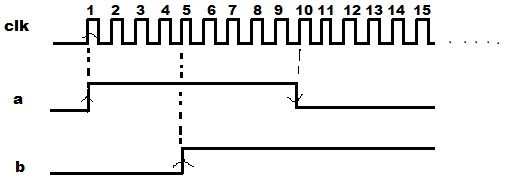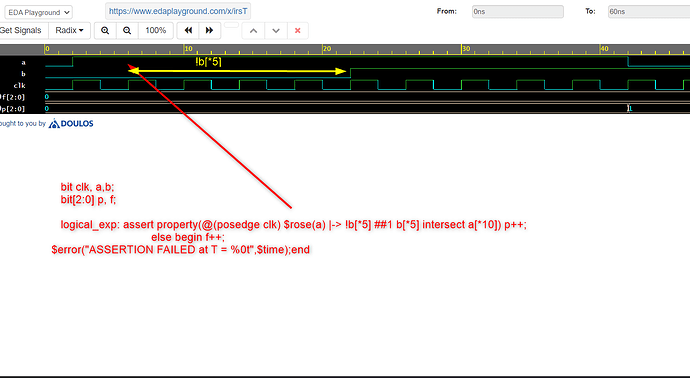
Q. Whenever sig_a rises, after 5 clk cycles sig_b should be high and it will be stable with sig_a for 5 clk cycles later sig_a will be low
Here You have to check for the first thing is about that when you want to check your design using assertion w.r.t. clk or etc? Then check the conditions as you said first a then after 5 clk cycle b should be check !..
module tb;
bit clk, a,b ;
always #2 clk = ~clk;
sequence seq;
a ##5 b;
endsequence
property prop;
@(posedge clk) seq;
endproperty
logical_exp: assert property(prop) else $error("ASSERTION FAILED at T = %0t",$time);
initial begin
@(posedge clk)
a = 1;
#16 b = 1;
#20 a = 0;
#20; $finish;
end
initial begin
$dumpfile("dump.vcd");
$dumpvars;
end
endmodule
/* Q. Whenever sig_a rises, after 5 clk cycles sig_b should be high
and it will be stable with sig_a for 5 clk cycles later sig_a will be low */
module tb;
bit clk, a,b;
bit[2:0] p, f;
always #2 clk = !clk;
logical_exp: assert property(@(posedge clk) $rose(a) |-> !b[*5] ##1 b[*5] intersect a[*10]) p++;
else begin f++; $error("ASSERTION FAILED at T = %0t",$time);end
initial begin
@(posedge clk)
a <= 1;
repeat(5) @(posedge clk);
b <= 1;
repeat(5) @(posedge clk);
a <= 0;
#20; $finish;
end
initial begin
$dumpfile("dump.vcd");
$dumpvars;
end
endmodule
Thank you @user49
Q: Does this check if sig_a will be low after 5 clks?
NO, but one could either add another assertion or modify this to something like:
assert property(@(posedge clk)
$rose(a) |-> (!b[*5] ##1 b[*5] intersect a[*10]) ##1 $fell(a));
// Note the ()
it all depends on the requirements. If that fell is important, then you can add that. I assumed it was not. But again, this exercise and the use of assertions demonstrate how requirements are clarified.
